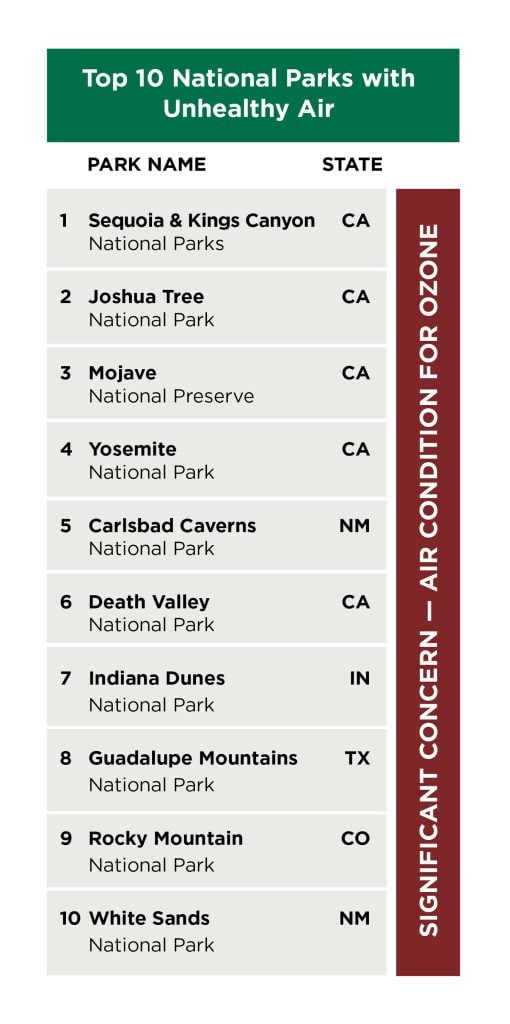

A 2024 report by the National Parks Conservation Association found that 97% of parks have unsatisfactory levels of visibility impairment overall, indicating they are far from achieving clean air or clear skies. This finding, drawn from National Park Service data, encapsulates three categories evaluated in NPCA’s report: Hazy Skies, Unhealthy Air and Harm to Nature. 98% of national parks in the United States grapple with concerning levels of haze pollution, obscuring the scenic views and landmarks that draw millions of visitors each year. The report shows that 96% of these parks face concerning levels of ozone pollution, increasing health risks, such as respiratory illnesses and asthma attacks, for staff, visitors and nearby communities. And it underscores that 96% of national parks harbor sensitive species and natural habitats adversely affected by pollution.
Four high risk climate threats, also assessed in the report, emphasize the urgent situation that parks face serious and irreparable consequences from rising global temperatures. Responding to this alarming reality, the report also outlines ways NPCA has led efforts to urge the implementation of time-tested, effective programs like the Regional Haze Rule, the strengthening of national air standards, improved air monitoring in and around national parks and lastly, the advancement of climate-friendly policies.
“Our new Polluted Parks report showcases that while we’ve made some progress toward cleaner air, the job is far from done to protect nature, scenic views, our climate and human health. Visitors to national parks expect clean air and clear skies whether they are visiting stunning wilderness landscapes or urban monuments.
“The trouble with air pollution is that it knows no bounds and harms the places we love and communities which rely on them for clean air and a healthy climate,” says Ulla Reeves, Interim Director of NPCA’s Clean Air Program. “It’s imperative that we take timely action to protect our national parks that we love, safeguard the climate and ensure the health and wellbeing of visitors, nature, wildlife and surrounding communities.”
The report highlights that while all national parks are struggling with the effects of a rapidly changing climate, 57% of national parks face high risk threats from specific consequences of climate change, including wildfires, droughts, sea-level rise, and invasive species. As iconic landscapes standing on the frontlines of the climate crisis, NPCA emphasizes the urgent need to cut the air pollution driving climate change and safeguard national parks for future generations.
NPCA takes a leading role in addressing these challenges, not only focusing on risks to air quality but also tackling the various climate risks identified in the report. In fact, NPCA’s leadership has resulted in the reduction of 1.4 million tons of visibility-impairing pollution reduced, the closure of cleanup of over 150 park-polluting coal plants and the elimination of 171 million metric tons of climate pollution. Still, NPCA remains dedicated to its collaborative efforts across state and federal agencies to ensure a healthier and sustainable future for these invaluable national parks. Data, like that highlighted in the Polluted Parks report, demonstrates the urgent need for swift action to curb pollution and allow these treasured places to recover from decades of industrial pollution.
Ozone, one of the most pervasive pollutants in parks, not only impairs scenic beauty but also poses a direct threat to human and wildlife health. It makes breathing more difficult and puts individuals with asthma or respiratory illnesses at significant risk. The impact is felt across the nation, from Hawaii’s iconic volcanoes to Kentucky’s Mammoth Cave, as Americans endure muddied views and skies choked with dirty air.
The full report and the interactive web platform showcasing all air and climate data are available for download and exploration here.